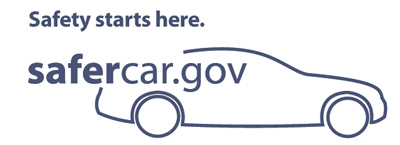|
|
WHAT IS THE 5-STAR SAFETY RATINGS SYSTEM?
FREQUENTLY ASKED QUESTIONS
Also called the New Car Assessment Program (NCAP), the 5-Star Safety Ratings System was created by the National Highway Traffic Safety Administration (NHTSA) to provide consumers with information about the crash protection and rollover safety of new vehicles beyond what is required by statute. One star is the lowest rating, five stars is the highest. More stars equal safer cars.
The 5-Star Safety Ratings System was initiated in 1978 to measure the level of increased safety for vehicle occupants in frontal crashes. Side crash rating results were added with 1997 model year vehicles and rollover assessments with 2001 models. This is a program that encourages manufacturers to voluntarily design safer vehicles by giving them safety ratings that can be used by consumers to compare vehicles when shopping for a new car.
5-Star Safety Ratings can be found on SaferCar.gov and are posted on the Monroney labels (window stickers) that are required to be displayed on all new vehicles.
Yes, other organizations test crash vehicles, but NHTSA is the only organization that rates rollover resistance in addition to frontal and side crash worthiness. 5. Why has the 5-Star Safety Ratings System changed and what is the program’s goal? As the 5-Star Safety Ratings of vehicles improved, the agency looked for new ways to encourage the continuous advancement of vehicle safety. Also, the agency wanted to provide more comprehensive information about vehicles to consumers so they can make more educated purchasing decisions. The additional testing and data that is reflected in the new ratings will better discriminate between the relative safety of vehicle models. NHTSA’s ultimate goal is to continuously improve occupant protection and crash avoidance by enhancing the incentives for vehicle manufacturers to improve the crash worthiness aspects of vehicles and include new safety technologies.
New criteria for the ratings system include side pole testing, using different sized test dummies, collecting more crash data, offering a single Overall Vehicle Score per vehicle, and highlighting new crash avoidance technologies.
While not part of the 5-Star Ratings System, NHTSA identifies if rated vehicles are also equipped with advanced technology features like Electronic Stability Control (ESC) , Lane Departure Warning (LDW), and Forward Collision Warning (FCW) to help consumers buy a safer car.
The changes were implemented beginning with 2011 model year vehicles.
The new 5-Star Safety Ratings are being displayed on the Monroney label beginning with MY 2012 vehicles.
Each year, NHTSA rates a sample of new vehicles that are predicted to have high sales volume, those that have been structurally redesigned, or those with improved safety equipment. Tested vehicles are purchased from dealerships across the country; the vehicles are not supplied directly to NHTSA by the manufacturer, a common misperception. For the 2011 model year, NHTSA estimates 60 percent of the light vehicle fleet will be rated. Though NHTSA is unable to rate every car, all vehicles sold in the U.S. must meet Federal Motor Vehicle Safety Standards.
Yes, NHTSA expects many star ratings to be lower. However, it does not mean that your current 4 or 5-star vehicle is unsafe. Due to more vigorous testing, a vehicle that once received 5 stars under the old system may receive a lower score under the new system even if no changes have been made to the model.
No, NHTSA will not revise the published safety ratings for any 2010 or prior model year vehicle. However, old ratings will still be available via the SaferCar.gov website. The new 5-Star Safety Ratings include, for the first time, an Overall Vehicle Score, and a combination of results from two side-impact crash tests. The intention of the new ratings and tougher crash tests is to encourage manufacturers to build the safest vehicles possible.
13. How does NHTSA perform the frontal crash test? Crash test dummies representing an average sized adult male and a small sized adult female are placed in the driver and front passenger seats, respectively, and are secured with seat belts. Vehicles are crashed into a fixed barrier at 35 miles per hour (mph), which is equivalent to a head-on collision between two similar vehicles each moving at 35 mph. Instruments measure the force of impact to each dummy’s head, neck, chest, pelvis, femur (legs), and feet. The frontal crash rating is an evaluation of injury to the head, neck, chest, and femur (legs) for the driver and right front seat passenger. Since the frontal crash test reflects a crash between two similar vehicles, only vehicles from the same weight class, plus or minus 250 pounds, can be compared when looking at frontal crash ratings.
Crash test dummies representing an average sized adult male and a small sized adult female are placed in the driver and rear passenger seats (driver’s side), respectively, and are secured with seat belts. The side crash rating represents an intersection type collision by having a 3,015 pound barrier moving at 38.5 mph into a standing vehicle. The moving barrier is covered with material that is crushable to replicate the front of a vehicle. Instruments measure the force of impact to each dummy’s body regions. The side barrier front seat rating is an evaluation of injury to the head, chest, abdomen, and pelvis for the driver and front seat passenger dummy. The side barrier rear seat rating is an evaluation of injury to the head and pelvis for the rear seat passenger (second row occupants). It is possible to compare all vehicles with each other when looking at side barrier ratings since all rated vehicles are impacted by the same sized barrier.
A small sized adult female crash test dummy is placed in the driver’s seat and is secured with a seat belt. The test vehicle, angled at 75 degrees, is then pulled sideways at 20 mph into a 25 cm diameter pole at the driver’s seating location. This test mimics a side impact crash involving a narrow, fixed object like a utility pole or tree. Instruments measure the force of impact to the dummy’s head, chest, lower spine, abdomen, and pelvis. Unless otherwise noted, the side pole rating is an evaluation of injury to the head and pelvis for both the driver and front seat passenger. It is possible to compare all vehicles to each other when looking at side pole ratings because all rated vehicles impact the same sized pole.
NHTSA combines the driver front seat rating from the side pole test with the driver front seat rating from the side barrier test for a combined side barrier and pole front seat rating. The probabilities of injury from the front and rear seat occupants in the side barrier test and the front seat occupant in the side pole crash test are then weighted and combined to assign a side crash rating. The side crash rating is compared to the side crash performance of an average vehicle in the fleet. A lower than average risk of injury is better; occupants in these vehicles will be less likely than average to sustain injury in side impact collisions with other vehicles or stationary objects such as trees and utility poles.
NHTSA’s 5-Star Ratings System has a limited budget and must concentrate its ratings on front and side impact crashes that are responsible for the highest percentage of deaths and serious injuries.
18. How does NHTSA categorize vehicles? NHTSA categorizes vehicles by class and “curb” weight. Curb weight is the weight of a vehicle with standard equipment including the maximum capacity of fuel, oil, coolant, and air conditioning. Passenger cars are further subdivided:
Side crash rating results can be compared across all classes because all vehicles are hit with the same force by the same moving barrier or pole. Roll over ratings can also be compared across all classes. Frontal crash rating results can only be compared to other vehicles in the same class and whose weight is plus or minus 250 pounds of the vehicle being rated. This is because a frontal crash rating into a fixed barrier represents a crash between two vehicles of the same weight.
This symbol alerts consumers to a safety concern the government has about the vehicle. That concern can include structural failure or some type of unintended performance of a vehicle component such as a fuel leakage or a door opening. Please note that safety concerns are NOT part of the calculation for an Overall Vehicle Score. A vehicle can have a high star rating, but still have a safety concern. However, if a safety concern is identified, the symbol will appear in the correct crash category and Overall Vehicle Score area.
© 2013 TLC Magazine Online, Inc. |





